4 Best Parental Control Apps for Teenagers in 2025
Monitoring my teenagers online can feel like a full-time job. They spend too much time looking at their phones, and any method I used to limit it failed. Not only I was needed a reliable parental control app, but it should also prevent my teens from disabling or finding hacks to get around my rules, which is hard to find.
In addition, and unlike with my younger kids, I needed a more sophisticated monitoring app for my teens that wouldn’t make them feel like I didn’t trust them. But at the same time, it would give me a glimpse into their life, just to make sure they are not being bullied or involved in a dangerous situation.
After testing more than 30 parental control apps, Qustodio stood out from them all. It has a comprehensive web filter, multiple screen time features, and detailed reporting. Perhaps best of all, I received a real-time alert any time the kids tried to bypass the rules. You don’t have to take my word for it, when you can get Qustodio free for 30 days – with no credit card required, to try it yourself and see how it works for your family.
Try Qustodio Free for 30 Days!
Short on Time: Here Are the Best Parental Control Apps for Teenagers — Tested in February 2023
- Qustodio: The overall #1 parental control app for teenagers with comprehensive web filter, multiple screen time tools, live location tracking, and unlimited geofences, and remote app management. Best of all, you can try Qustodio free for 30 days.
- Norton Family: Robust web filter with 40 categories, set rules for when teens are in school and studying, but no time limits for individual apps.
- mSpy: Records every action your teenager does on their phone with screenshots and a keylogger, but it has no web filter.
- Mobicip: Flexible screen time tools, web filter with 17 categories, but app management tool is limited.
Try Qustodio Free for 30 Days!
The 4 Best Parental Control Apps for Teenagers – Tested in 2025
1. Qustodio: Best Parental Control App for Teens with Robust Features That Can’t be Bypassed
- Web filter with 29 categories and customization options
- Multiple screen time features, including instant lock
- Call and SMS monitoring
- Live location tracking and unlimited geofences
- Real time alerts and detailed usage reports
- 30-day free trial – no credit card required
Qustodio is the most complete parental control app that I tested on my teenagers. It has the necessary features to monitor their online actions and prevent them from getting in trouble. Best of all, the teenagers weren’t able to disable Qustodio or get around the rules without me knowing.
The web filter has 29 categories, and it’s fully customizable. I could set different rules for my 13-year-old daughter and 17-year-old son. Additionally, Qustodio knows some popular hacks that kids use to beat the filter and included the following 3 options in the setting to prevent them from occurring:
- Automatically block any unsupported browser
- Block any website that isn’t categorized
- Activate safe search results on major search engines
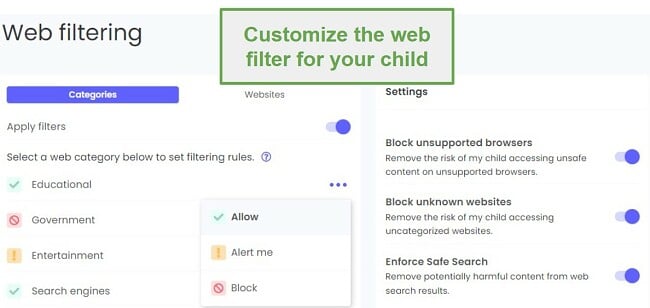
Getting my teens to look up from their screens has always been a challenge. With Qustodio, I rarely have to tell them to put down their phones. I can set a schedule of when the phone is blocked, limit the screen for individual apps, and set an overall daily time limit. My kids tried using a VPN to get around the screen time limits, but Qustodio recognized the hack and continued blocking the device.
There is a call and SMS monitoring feature. I find that being able to see who my kids are talking to and being able to read their messages gives me valuable insight into their lives. If I see that one of their contacts is someone I don’t want them talking with, whether they’re a cyberbully or pressuring my kids, for example, to drink, do drugs, or have sex, I can block them from calling or texting.
Another essential feature is location tracking. I can open the dashboard and see exactly where my teens are and where they’ve been at any point over the past 30 days. Now, I don’t have to get into discussions or arguments about “where are you going” or “where have you been”. If there is an area or a location that I don’t want my teens to go, I can create a geofence and get an instant alert when they enter and leave these forbidden zones.
Qustodio is easy to manage from the cloud-based dashboard. I can make changes to any of the rules, view alerts, and generate daily, weekly, and monthly reports.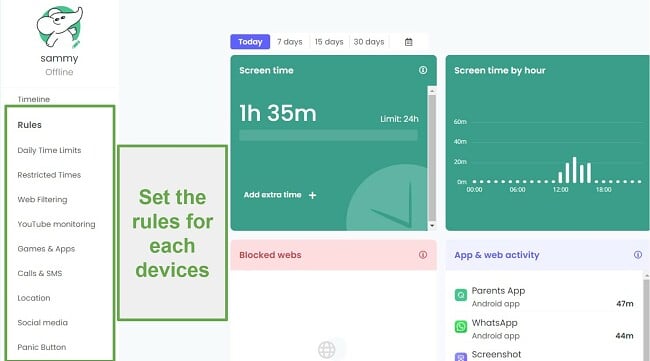
If you’re using Qustodio to monitor your teen’s computer or Mac, there is the option to hide the app icon. While this option isn’t available on mobile devices, the app can’t be deleted without the parents receiving an alert. You can get access to all the premium features free for 30 days when you register a Qustodio account. There is no obligation, and you don’t have to enter your credit card information to start the free trial. It is a great opportunity to run a real-world test and see how Qustodio works with your teenagers.
2. Norton Family: Help Teens Focus on School and Enforces Screen Time Limits
- Customizable web filter with over 40 categories
- Monitors what apps are on your teen’s device and time spent using them
- Records search history and enforce Safe Search on major search engines
- Multiple screen time tools, including Instant Lock
- Try it risk-free with 30-day free trial
When my teenage son started getting in trouble because he wasn’t focusing at school or doing his homework, I thought it had to do with how much time he spent on his phone. I installed Norton Family on his phone because of the School Time feature. Instead of taking away his phone or blocking the internet, both of which he needs for school, I could adjust what websites and apps are available.
The School Time feature is easy to enable and comes with a default list of websites that it won’t block, in case that I want to allow my kid to access them. I could add websites to the list, such as his class site and homework portal, which are for educational use and I don’t want them to be blocked.
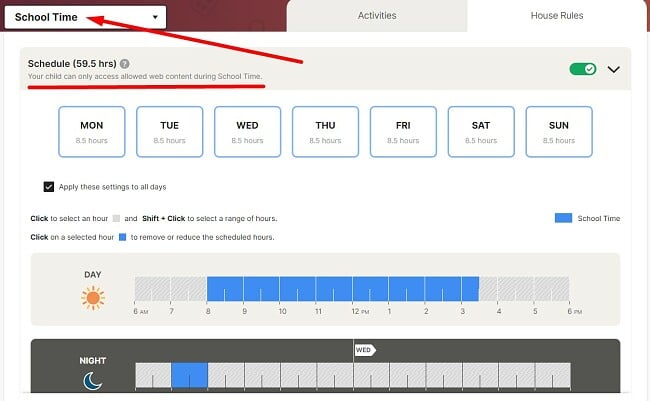
The regular screen time rules are very strong, and my teenagers couldn’t unblock their phones. I set an overall limit and created a usage calendar for when the phone was available. However, I was disappointed that the schedule was restricted to 30-minute time blocks, as opposed to more flexible options, like 5-minute increments.
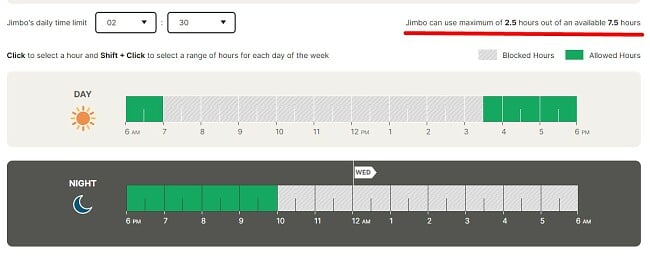
The app monitoring gives me a full list of all apps installed and uninstalled on my kids’ phones and tablets. At first, I wasn’t sure why I needed to see what apps were uninstalled until I realized that if I blocked an app with Norton Family, the kids could uninstall and reinstall that app, and the block would be removed. Now, I’ll know if they use this tactic.
The one feature upgrade I’d like to see here is the ability to add screen time limits for individual apps because I think it’s as important as general screen time limits.
Norton Family has a 30-day free trial that gives you unlimited access to all premium features, so you’ll have enough time to test the app and see if this is the right parental control app for you.
Try Norton Family Risk-Free for 30 Days!
3. mSpy: Records Every Keystroke and Takes Screenshots of Every Action Taken on the Device
- Records call logs and display conversations from SMS & messenger apps
- Allows parents to create a blocklist of keywords and websites
- Tracks live location and has the option for custom geofences
- 14-day money-back guarantee
mSpy is a different type of parental control app when compared to the others on this list. Instead of enforcing web filters and screen time limits, mSpy gives parents unfiltered access to their teen’s activities on their phones and tablets. So, I’ll know exactly who they’re talking to, what they’re looking at, and where they are at all times.
I installed it on my son’s phone, and it instantly started taking screenshots every few minutes or when a new action, such as opening a new website or app, occurred. Additionally, the keylogger recorded everything my son typed on his phone, and all this data was uploaded and organized in the parental dashboard.

While there are no web filters or screen time limits, mSpy does have some useful parental control features. I can see the apps that my teen has installed on his phone, and if there are apps I don’t approve of, I can block them. There is also the option to create a custom list of keywords, phrases, and slang terms. mSpy will notify me if these words are used on the phone. The only downside is that there isn’t a default list that I can add to. instead I have to come up with the list myself.
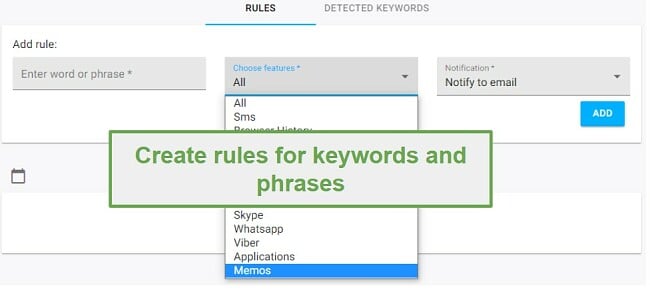
Another great feature of mSpy is its ability to track the child’s location in real-time. This way, I can check where my child is and take action if I suspect that he is in danger. This can be particularly useful for parents who have children who are prone to wander or who are in the habit of staying out late. Another helpful feature is the geofence. I can mark areas as a Safe Zone or a Forbidden Zones and get alerts when my son enters and leaves that area.
mSpy is a good option if you need an inside look at your teenager’s digital life. While there isn’t a free trial, the mSpy website has a demo of the app so you can see a complete breakdown of how the dashboard is organized and all the information it tracks. There is a 14-day money-back guarantee, so you can try it out on your child’s phone or tablet and see if it’s the right choice for your needs.
Try mSpy Risk-Free for 14 Days
4. Mobicip: Web Filter has 18 Categories, and It’s Difficult to Bypass
- Multiple screen time limit features and a Vacation Mode
- Monitors some social media networks for dangerous or inappropriate content
- Manages apps by grouping them into categories
- 7 day free trial
Upon evaluating Mobicip, I found that the application performs various tasks proficiently, yet it lacks a standout attribute. The web filter encompasses 18 categories, placing significant emphasis on subjects such as sexual content, drugs, alcohol, and health. By default, the app grants teenagers considerable freedom; however, there is an option to personalize the activated categories in case you feel that the default settings permit an excessive amount of potentially inappropriate content to remain unblocked.
The screen time feature has a customizable schedule and overall daily limit. I like this because I can not only decide how much screen time my teens can have but when they can be on the phone or computer. One feature I like is the Vacation Mode, which allows me to temporarily disable the screen time limits and automatically restart them after vacation.
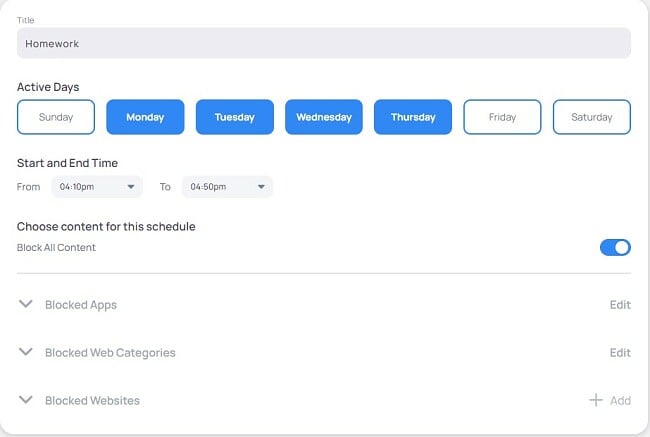
The social media monitoring features are compatible with Facebook, Instagram, and Snapchat (Android only). I can connect my teens account to Mobicip and get alerts when images, posts, or comments trigger the filter based on bullying, sex, violence, drugs, and self-harm.
The app management feature groups all apps into the following three categories: Social Media, Entertainment, and Games. It then gives me the option to set time limits for an entire category or set limits on an individual app.
You can test Mobicip yourself free for 7 days and experience all the premium features in a real-world environment.
Why You Should Avoid Free Parental Control Apps to Monitor Your Teens
To be honest, most of the free parental control apps I tested weren’t worth the time it took to download and install on my kids’ phones. Some of the main issues I had were the apps didn’t work, the kids could simply delete the app, and one really slowed down my son’s phone.
Besides that, I had other issues with the free apps:
- Limited features: At best, a free parental control app will have some very basic features, such as screen time limits and a web filter. Assuming these work (which is a big “If”), you’ll still be missing out on advanced features such as social media monitoring, location tracking, and detailed device management.
- Lack of security: After reading through multiple privacy policies, I saw that the security of free parental control apps is often weaker than that of paid options. This means that sensitive data, such as the teenager’s online activities, may be vulnerable to hacking or unauthorized access.
- Inaccurate monitoring: Some free parental control apps rely on self-reported data, which can be unreliable and inaccurate. For example, the teenager may be able to bypass the app’s restrictions or hide certain activities. This can make it difficult to get an accurate picture of your teen’s online activities.
- Inefficient blocking: The free apps that I tested didn’t do a good job when it came to blocking inappropriate content, such as harmful websites or adult content. My kids used several hacks, including a VPN and incognito mode, to access any website they wanted.
- Privacy concerns: Free parental control apps have to make money, and if it’s not from subscription fees, it has to be through data-sharing. In this case, your teen becomes their product, and they may collect and share user data with third-party marketers. This can lead to sensitive information, such as the teenager’s online activities or location, being shared with companies that may use it for marketing or other purposes.
And yes, I tried Google Family Link, and it was a huge disappointment. After creating accounts for the kids, I found out that kids 13 and over (the age can vary based on your country of residence) can just opt out of parental supervision, so what’s the point of using it.
If you’re still looking for a free solution, try Qustodio free for 30 days, to get valuable insights into how your teens use their phones.
How I Tested and Ranked the Best Parental Control Apps for Teens
As a parent to three teenagers, I know first-hand how difficult it is to ensure their safety and well-being, especially when it comes to online activities. I downloaded over 20 apps and installed them on my kids’ phones and tablets, each for a maximum of a week. I compared how difficult it was to set up, checked the features to make sure they worked and couldn’t be bypassed, and looked through the reports to make sure they gave actionable and valuable information. Based on these tests, I selected the top 5 parental control apps for teens.
The following are the factors you should consider when choosing a parental control app for your teenager:
- Content Filtering: One of the most important functions of a parental control app is the ability to block inappropriate websites and limit access to certain apps. This helps protect your teen from exposure to harmful or explicit content.
- Screen Time Management: Screen time has become a big concern for many parents, as it can lead to addiction, disrupted sleep patterns, and other negative impacts on mental and physical health. A good parental control app should allow you to set daily or weekly limits on your teen’s device usage.
- Location Tracking: Knowing your teen’s whereabouts is important for their safety. Some parental control apps come with GPS tracking features, allowing you to keep tabs on their location in real-time.
- Ease of Use: A parental control app should be easy to set up and use. You don’t want to spend hours configuring it or navigating a complicated interface.
- Compatibility and cross-platform capabilities: Make sure the app is compatible with your teen’s device and operating system. If you want to monitor multiple devices on different platforms, make sure that you get an app that can monitor multiple devices at the same time, and works across multiple platforms (Android, iOS, PC, macOS, Kindle, etc).
- Privacy: Some parental control apps collect a lot of personal data. It’s important to choose one with a clear privacy policy that only collects the data it needs to function.
- Free Trial: Teens can have different reactions to parental control apps. I like having the option to test the app on my teens before committing to a subscription plan. Qustodio really stood out from the others here with a 30-day free trial, and no credit card was required to activate the account.

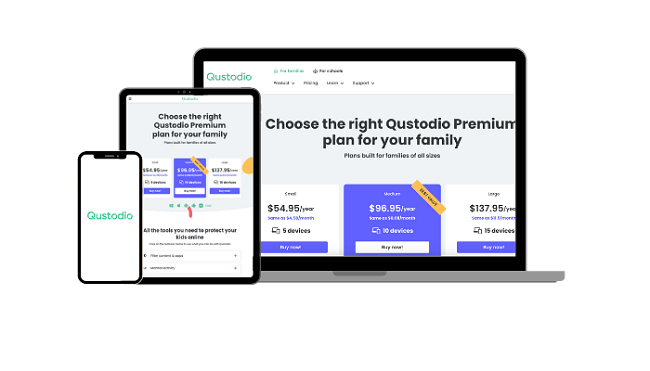
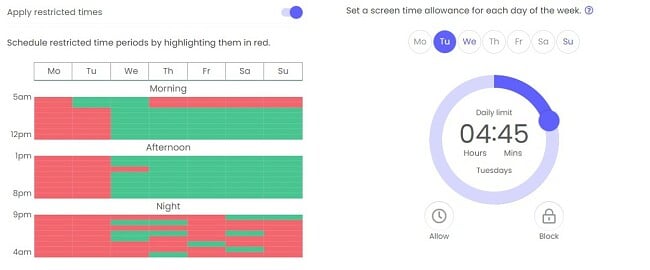
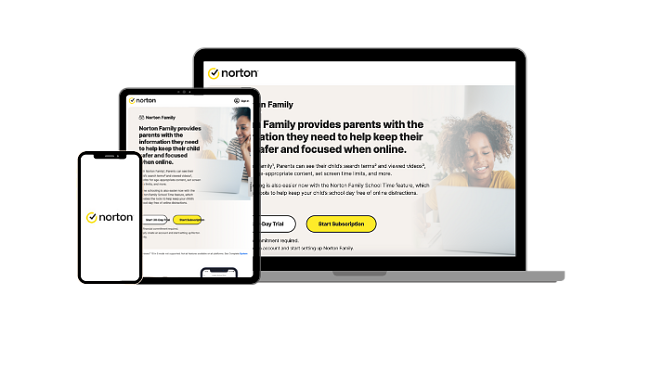
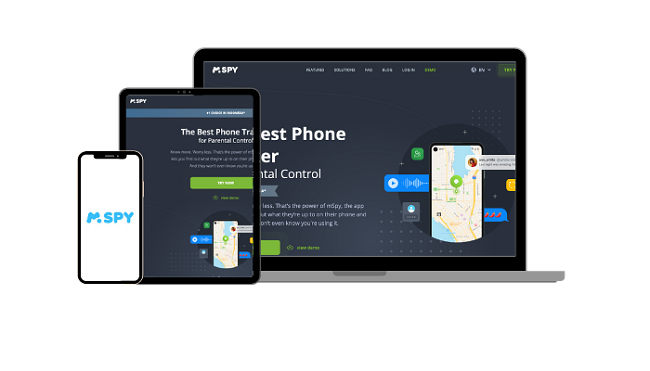
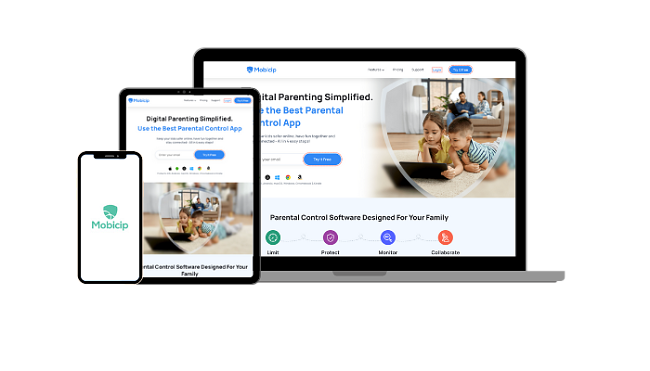

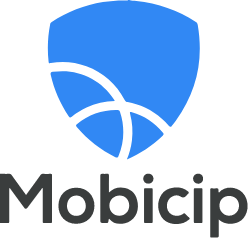


Leave a Comment
Cancel